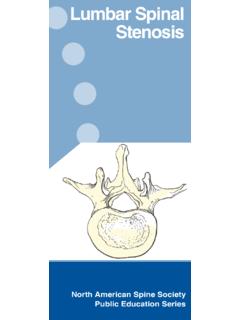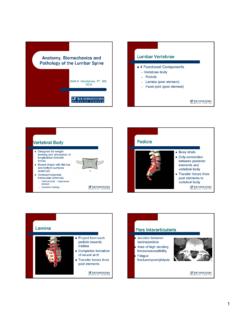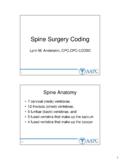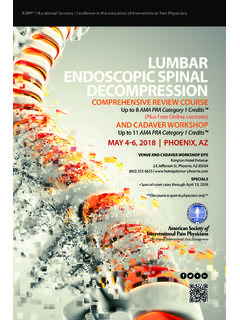Transcription of Rehabilitation Status Post Spinal Fusion - nhmi.net
1 9/2/14 1 Rehabilitation Status Post Spinal Fusion Eric Gattie PT, DPT, OCS, FAAOMPT, ATC, CSCS Objectives n Outcomes n Challenges n Current state of evidence n Therapeutic neuroscience education (TNE) n Post operative restrictions n Exercise interventions The Numbers } The likelihood of having Spinal surgery in the United States is 5 times higher than that of the United Kingdom, and 2 times that of Australia, Canada and Scandinavian countries.(Lurie Spine 2003) An important reason to examine such questions is thatmany adverse events following surgery are unavoidableconsequences of the physiologic insult to patients. Indeed,some studies have suggested that only a minority ofadverse events are a result of physician negligence.
2 Afamiliar example occurs in drug prescribing, where anegative drug reaction may occur in a patient for whom adrug has been appropriately prescribed for the first is an adverse event, but not one that is due tonegligence. However, if a drug reaction occurs in apatient with a known sensitivity to the drug, this adverseevent would be properly judged to be caused by negli-gence [1]. In a review of 30,000 patient records from 50hospitals, adverse events were identified in of hos-pital stays, but adverse events caused by negligenceoccurred in only 1% [2]. Thus, a majority of adverseevents may be an unavoidable feature of care, making thequestion of whether the care was necessary an importantquality the field of spine surgery, there is persistent contro-versy about the indications for certain types of electivesurgery, whether or not a Fusion is required in addition to adecompression procedure, and when surgical implants arenecessary [3].
3 Furthermore, one can make a case that atleast in some regions, spine surgery, Fusion procedures, andsurgical implants may be overused. If this is true, thenassessing the need for surgery in the first place, or thechoice of a procedure, becomes prominently important inquality there evidence of excessive spine surgery?There is probably no definitive way to determine whetherthere is excessive spine surgery. As yet, we have no goldstandard for determining the need for what are usuallyelective procedures, involving major components of phy-sician judgment and patient preference. Patients may notfully understand the options available to them, includingthe choice of nonsurgical care.
4 Yet randomized trialssuggest that for the example of patients with sciatica,surgical and non-surgical care may have similar long termoutcomes, though with a short-term advantage for lines of evidence suggest that, at least in somecountries and regions, spine surgery may be performedmore often than necessary. These can be briefly summa-rized as comparisonsRates of spine surgery vary dramatically from one countryto the next, even among highly developed countries. TheUnited States performs spine surgery at roughly twice therate of most developed countries. The most recent formalcomparisons suggest that the US rate is roughly twice thatin New Zealand, Australia, Canada, Norway and Finland( ).
5 Spine surgery rates in the United Kingdom areabout one-fifth of the US rate [4]. We have little reason tobelieve that there are biological differences from country tocountry, and epidemiologic studies suggest that rates ofback pain are similar among geographic areas. Differencesin health care organization and financing, surgical queues,patient expectations, surgical training, and professionaluncertainty may explain some of these variations, butbiological explanations seem unlikely. Although it may bethat every other nation is underperforming spine surgeryand that the US rate is optimal, it seems equally likely thatlower rates may be optimal, and the US and other high ratecountries may be performing excessive geographic variationsEven within countries, there are typically wide geographicvariations in rates of spine surgery [5].
6 For example, oneUS study of the Medicare population showed 8-foldregional variation in rates of Spinal decompression, and 20-fold variation in rates of Spinal Fusion [6]. To manyobservers, this suggests a poor consensus regarding indi-cations for spine surgery and again raises the likelihoodthat rates may be excessive in some in surgery ratesThere is little reason to believe that anatomic abnormalitiesof the spine are becoming more common, and yet surgeryrates, at least in the US, are steadily increasing [7]. This isnot simply due to aging of the population, because moststudies report age-adjusted rates. One study demonstrated a220% increase in Spinal Fusion surgery in particular,between 1990 and 2000 ( )[8].
7 This occurred in theabsence of clarified indications or new demonstrations NOR FINSCO ENGSWE NZAUSDEN NET AustraliaDEN-DenmarkENG-EnglandFIN-Finla ndMAN-ManitobaNET-NetherlandsNZ-New Zealand NOR-Norway States Fig. 1 Ratio of back surgery rate in selected countries to backsurgery rate in the US (1988). (Adapted with permission from Spine,1994, Lippincott Williams and Wilkins [4])S332 Eur Spine J (2009) 18 (Suppl 3):S331 S337123 Norwegian Manual Therapy Oslo March 2012 Adriaan Louw, PT, PhD (c), (physio) 2 Increased Lumbar Fusions Between 1996 2001 Spinal fusions rose by 77% Total hip arthroplasty (THA) and total knee arthroplasty (TKA) rose by 13% 4 Deyo RA, Mirza SK.
8 Trends and variations in the use of spine surgery. Clin Orthop Relat Res. Feb 2006;443:139-146. The Numbers } In the USA lumbar Fusion surgery rates have increased 220% from 1990 to 2001,(Deyo Spine 2005, Gray Spine 2006) } This led to a 500% increase in spending for lumbar Fusion from 1992 to 2003. (Weinstein Spine 2006) efficacy for spine Fusion . In fact, the increase precededpublication of the first randomized trial of Fusion versusnonsurgical therapy for discogenic back pain. Althoughcausal inferences cannot be made, there was a sharpacceleration in Fusion rates after 1996, coinciding with theintroduction of intervertebral interbody Fusion cages [8].
9 Other studies demonstrated that during the last 5 yearsof the 1990s, spine surgery rates in the Medicare popula-tion increased 40%; spine Fusion rates increased 70%; andinstrumented Spinal fusions increased 100% [9]. A reviewof published literature similarly demonstrated a substantialincrease in the use of Fusion surgery and instrumentationfrom the 1980s to the 1990s, but with little change inreported solid Fusion rates or in clinical outcomes [10].Surgical outcomesA study in the state of Maine identified regions that had low,intermediate, or high rates of lumbar spine surgery. In aprospective cohort study that involved most of the spinesurgeons in the state, preoperative data were collected andpost-operative follow-up was obtained over 2 4 years.
10 Byeach of the outcomes measured (Roland Disability Score,satisfaction with surgical outcome, and rates of disabilitycompensation) the best results occurred in areas with thelowest surgery rates and the worse outcomes occurredin areas with the highest surgical rates. The region withintermediate surgical rates had intermediate outcomes oneach measure (Table1)[11]. Although we cannot commenton outcomes for the patients who did not undergo surgery,these results suggest that higher rates of surgery did notnecessarily lead to better outcomes. This seems consistentwith randomized trial results for sciatica that show sub-stantial improvement even with nonoperative opinionIn the US, several prominent surgeons have voiced theopinion that excessive Spinal Fusion surgery is beingperformed.












